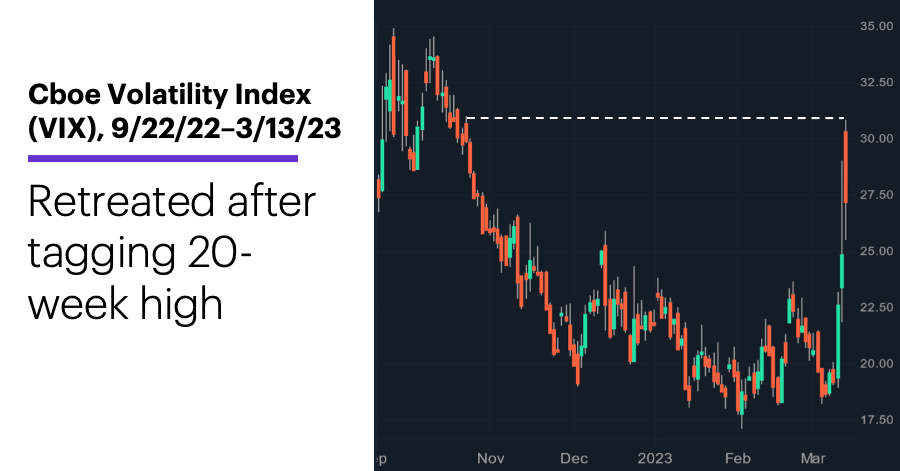Volatility check
- Stocks stabilized Monday after early sell-off
- Federal regulators guaranteed deposits in shuttered banks
- Odds of 0.25% rate hike increased?
While the bank-sector story is still playing out, the market’s recent behavior has been typical of the volatility that has accompanied all manner of “shocks” over the years. What investors and traders may want to keep in mind now is how the current situation dovetails with the larger market story that has been unfolding over the past year.
Some highlights from the past few days:
•Backstop: On Monday morning President Biden confirmed what federal regulators had stated over the weekend: All deposits in Silicon Valley Bank and Signature Bank—the two banks that were closed on Friday and Monday, respectively—would be guaranteed by the government (shareholders would not).1
•Banks down, broad market losses limited. The banking sector extended its pullback on Monday (concentrated in regional banks), but the broad market was more resilient, closing slightly lower for the day.
•Fed to scale back later this month? After Monday’s trading session, the CME Group FedWatch Tool showed roughly 55% odds of a 0.25% rate hike at the Fed’s March 21-22 meeting (rather than the previously expected 0.5% increase). The odds for no change in rates was 45%.
On Monday, the S&P 500 (SPX) fell as much as 1.4% shortly after the open, but climbed back into positive territory roughly 90 minutes into the trading day. It fluctuated throughout the remainder of the session, slipping back into the red by the close:

Source: Power E*TRADE. (For illustrative purposes. Not a recommendation.)
Meanwhile, the Cboe Volatility Index (VIX) quickly jumped 24% to its highest level since October 24 (30.79), but ultimately closed up less than 7%:

Source: Power E*TRADE. (For illustrative purposes. Not a recommendation.)
Monday’s relative broad-market resilience doesn’t necessarily signal the end of the bank story—or the larger factors that were at work in the market before it emerged. On Monday, Morgan Stanley & Co. cautioned against buying into any rally based on the government’s intervention in the banking sector, and reiterated the US market had the potential to hit new bear-market lows.2 (For perspective, the SPX’s October closing low of 3,577.03 is less than 8% below yesterday’s close.)
Market disruptions like this may be unwelcome—and uncomfortable, especially after an extended period of falling prices—but they’re an inevitable part of being in the markets. Investors shouldn’t let them alter their long-term plans, and traders are always wise to consider risk first, and potential profits second.
Note: Additional information about Silicon Valley Bank and Signature Bank can be found on the FDIC website or by calling 866-799-0959.
Today’s numbers include (all times ET): NFIB Small Business Optimism Index (6 a.m.), Consumer Price Index, CPI (8:30 a.m.).
Today’s earnings include: J.Jill (JILL), Skillz (SKLZ), Smartsheet (SMAR), Lennar (LEN).
Click here to log on to your account or learn more about E*TRADE's trading platforms, or follow the Company on Twitter, @ETRADE, for useful trading and investing insights.
1 Reuters. U.S. Treasury says Silicon Valley Bank, Signature Bank 'not being bailed out'. 3/12/23.
2 CNBC.com. Morgan Stanley’s Mike Wilson says sell any bounce on this government intervention, next leg of bear market has begun. 3/13/23.